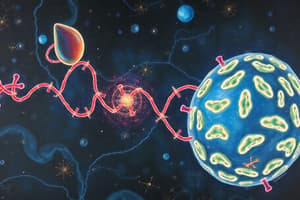Podcast
Questions and Answers
How many protons are pumped by 1 molecule of NADH?
How many protons are pumped by 1 molecule of NADH?
- 2
- 1
- 3 (correct)
- 4
FADH2 produces more ATP than NADH in oxidative phosphorylation.
FADH2 produces more ATP than NADH in oxidative phosphorylation.
False (B)
What is the total ATP yield from one mole of glucose during oxidative phosphorylation?
What is the total ATP yield from one mole of glucose during oxidative phosphorylation?
36 or 38 ATP
Glycogen is stored in the body to provide a rapidly mobilized form of __________.
Glycogen is stored in the body to provide a rapidly mobilized form of __________.
Match the following substrates with their respective metabolic pathways:
Match the following substrates with their respective metabolic pathways:
Which shuttle converts NADH into FADH2 inside the mitochondria?
Which shuttle converts NADH into FADH2 inside the mitochondria?
Glycolysis occurs in the mitochondria.
Glycolysis occurs in the mitochondria.
Name one enzyme involved in gluconeogenesis.
Name one enzyme involved in gluconeogenesis.
In the oxidative state, __________ can enter from Complex I.
In the oxidative state, __________ can enter from Complex I.
Which of the following is NOT a source of blood glucose?
Which of the following is NOT a source of blood glucose?
What type of molecule is glycogen?
What type of molecule is glycogen?
Glycogen functions only in the liver for glucose regulation.
Glycogen functions only in the liver for glucose regulation.
What is the main function of glycogen in the liver?
What is the main function of glycogen in the liver?
The branching part of glycogen is linked by ______ bonds.
The branching part of glycogen is linked by ______ bonds.
Match the metabolic pathways with their functions:
Match the metabolic pathways with their functions:
What is the role of UDP in glycogen synthesis?
What is the role of UDP in glycogen synthesis?
Ribose 5-phosphate is involved in the synthesis of nucleotides and nucleic acids.
Ribose 5-phosphate is involved in the synthesis of nucleotides and nucleic acids.
Name one product of the oxidative reactions in the pentose phosphate pathway.
Name one product of the oxidative reactions in the pentose phosphate pathway.
What does a negative ΔG value indicate about a reaction?
What does a negative ΔG value indicate about a reaction?
Oxidative phosphorylation involves the use of ATP as an electron carrier.
Oxidative phosphorylation involves the use of ATP as an electron carrier.
What are the main roles of glycolysis?
What are the main roles of glycolysis?
The __________ cycle is also known as the citric acid cycle.
The __________ cycle is also known as the citric acid cycle.
Match the following processes with their correct descriptions:
Match the following processes with their correct descriptions:
Which of the following is a method of ATP production?
Which of the following is a method of ATP production?
The main function of the TCA cycle is to harvest low-energy electrons from carbon fuels.
The main function of the TCA cycle is to harvest low-energy electrons from carbon fuels.
What are NADH and FADH2 primarily used for in bioenergetics?
What are NADH and FADH2 primarily used for in bioenergetics?
The process of converting pyruvate into Acetyl-CoA links glycolysis to the _________ cycle.
The process of converting pyruvate into Acetyl-CoA links glycolysis to the _________ cycle.
Match the following metabolic pathways with their purposes:
Match the following metabolic pathways with their purposes:
Which molecule is produced when ATP is hydrolyzed?
Which molecule is produced when ATP is hydrolyzed?
Substrate-level phosphorylation occurs in both glycolysis and the TCA cycle.
Substrate-level phosphorylation occurs in both glycolysis and the TCA cycle.
What is the primary energy currency of the cell?
What is the primary energy currency of the cell?
NAD+ is regenerated during the process of _________ when oxygen is absent.
NAD+ is regenerated during the process of _________ when oxygen is absent.
Flashcards
Bioenergetics
Bioenergetics
The study of energy transfer and utilization within living organisms.
Free Energy Change (ΔG)
Free Energy Change (ΔG)
The energy difference between reactants and products in a reaction.
Exergonic Reaction
Exergonic Reaction
A reaction that releases energy, making it spontaneous.
Endergonic Reaction
Endergonic Reaction
Signup and view all the flashcards
ATP (Adenosine Triphosphate)
ATP (Adenosine Triphosphate)
Signup and view all the flashcards
Substrate-level Phosphorylation
Substrate-level Phosphorylation
Signup and view all the flashcards
Oxidative Phosphorylation
Oxidative Phosphorylation
Signup and view all the flashcards
Glycolysis
Glycolysis
Signup and view all the flashcards
Gluconeogenesis
Gluconeogenesis
Signup and view all the flashcards
Pentose Phosphate Pathway
Pentose Phosphate Pathway
Signup and view all the flashcards
Glycogenolysis
Glycogenolysis
Signup and view all the flashcards
Glycogenesis
Glycogenesis
Signup and view all the flashcards
Citric Acid Cycle (TCA Cycle)
Citric Acid Cycle (TCA Cycle)
Signup and view all the flashcards
Electron Transport Chain (ETC)
Electron Transport Chain (ETC)
Signup and view all the flashcards
Pyruvate Oxidation
Pyruvate Oxidation
Signup and view all the flashcards
Glycogen
Glycogen
Signup and view all the flashcards
Citric Acid Cycle
Citric Acid Cycle
Signup and view all the flashcards
Electron Transport Chain
Electron Transport Chain
Signup and view all the flashcards
What is the Electron Transport Chain (ETC)?
What is the Electron Transport Chain (ETC)?
Signup and view all the flashcards
What are NADH and FADH2 and where do they enter the ETC?
What are NADH and FADH2 and where do they enter the ETC?
Signup and view all the flashcards
How does the ETC generate a proton gradient?
How does the ETC generate a proton gradient?
Signup and view all the flashcards
What is ATP synthase and how does it work?
What is ATP synthase and how does it work?
Signup and view all the flashcards
What is glycolysis?
What is glycolysis?
Signup and view all the flashcards
What is the pyruvate dehydrogenase (PDH) complex?
What is the pyruvate dehydrogenase (PDH) complex?
Signup and view all the flashcards
What is the Krebs cycle?
What is the Krebs cycle?
Signup and view all the flashcards
What is the malate-aspartate shuttle?
What is the malate-aspartate shuttle?
Signup and view all the flashcards
What is the glycerol 3-phosphate shuttle?
What is the glycerol 3-phosphate shuttle?
Signup and view all the flashcards
What is gluconeogenesis?
What is gluconeogenesis?
Signup and view all the flashcards
Study Notes
Bioenergetics
- Bioenergetics is the transfer and utilization of energy in biological systems.
- Bioenergetics predicts if a process is possible, while kinetics measures the reaction rate.
- Enzymes do not change the Gibbs free energy (ΔG) of a reaction, they lower the activation energy
- A spontaneous reaction has a negative ΔG (exergonic), meaning it releases energy.
- A non-spontaneous reaction has a positive ΔG (endergonic), meaning it requires energy input.
- ATP (adenosine triphosphate) is a high-energy molecule that stores and releases energy for cellular processes.
- ATP provides energy for various cellular processes through the breakdown of its phosphate bonds.
- Different types of reactions can be coupled to facilitate unfavorable reactions.
ATP Production
- Substrate-level phosphorylation is a metabolic reaction that results in the formation of ATP. It occurs during glycolysis.
- Oxidative phosphorylation is a metabolic pathway that produces ATP through the oxidation of NADH and FADH2. It involves the electron transport chain (ETC).
Carbohydrate Metabolism
- Glycolysis is the metabolic pathway that breaks down glucose into pyruvate.
- Glycolysis produces ATP and NADH as energy carriers.
- Glycolysis produces intermediates that can be used in other metabolic pathways.
- Glycolysis takes place in the cytoplasm of the cell.
- Glycolysis takes place in two separate stages: the investment phase and the harvest phase.
- Gluconeogenesis is the process of synthesizing glucose from non-carbohydrate precursors.
- There are three regulated steps in Glycolysis and they are often regulated in response to hormonal cues.
TCA Cycle
- The citric acid cycle, also called the tricarboxylic acid cycle or the Krebs cycle, is a central metabolic pathway for the oxidation of Acetyl-CoA.
- The TCA cycle is localized in the mitochondrial matrix.
- The TCA cycle generates high-energy electrons (NADH and FADH2) and CO2.
- Pyruvate is transported from the cytoplasm to the matrix in the mitochondria.
- The TCA cycle happens inside the mitochondria.
Oxidative Phosphorylation and ETC
- Electrons from NADH and FADH2 are transported through a series of protein complexes called the electron transport chain (ETC).
- The flow of electrons through the ETC creates a proton gradient across the inner mitochondrial membrane.
- ATP is synthesized by ATP synthase using the energy from the proton gradient.
- NADH produces more ATP than FADH2.
Pentose Phosphate Pathway
- The pentose phosphate pathway is an alternative pathway for glucose metabolism.
- This pathway produces NADPH, a reducing agent required in various biosynthetic reactions.
- This pathway produces Ribose 5 Phosphate, a precursor for nucleotide synthesis.
- This pathway has two phases. The oxidative phase and the non-oxidative phase.
Glycogen
- Glycogen is a storage form of glucose in animals.
- Glycogen is primarily stored in the liver and muscles.
- Glycogen synthesis and degradation are regulated processes.
Glycogen Metabolism
- Glycogen synthesis involves the activation of glucose and its incorporation into a glycogen molecule
- Glycogen degradation involves the cleavage of glucose from the end of a glycogen chain
Hormonal Regulation of Glycolysis
- Hormones like insulin and glucagon regulate glycolytic activity depending on the body needs.
Transfer of Cytoplasmic NADH to Mitochondria
- Cytoplasmic NADH cannot directly enter the mitochondria and must use a shuttle system.
- Two common shuttle mechanisms are the malate-aspartate shuttle and the glycerol 3-phosphate shuttle.
Studying That Suits You
Use AI to generate personalized quizzes and flashcards to suit your learning preferences.



